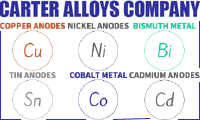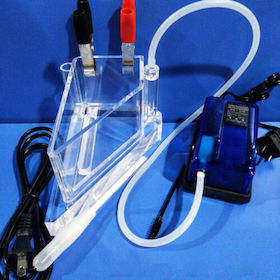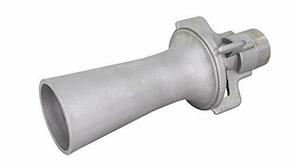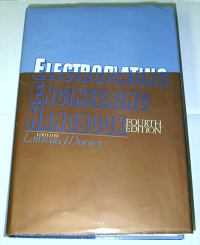
Curated with aloha by
Ted Mooney, P.E. RET

The authoritative public forum
for Metal Finishing 1989-2025

-----
Problem in Wood's Nickel Strike
Q. We are experiencing a peculiar and frustrating problem with our Wood's Nickel Strike bath, hope somebody out there can steer us in the right direction.
We are rack plating nickel + gold on brazed ceramic packages, for which the principal basis metals to be plated are alloy 42 (iron/nickel alloy) and copper (OFHC high purity C102 copper). In the plating line we are using a standard alkaline cleaner followed by a 5% HCl dip, Wood's strike, then nickel + gold plating.
We are finding that the Wood's nickel strike does not always cover the copper portion of the workpiece; the performance in this regard is very erratic (sometimes it seems to work, other times hardly at all). We are running the bath at 300 g/l NiCl2 X 6 H2O and 12.5% v/v HCl, 90 °F (that's room temp here in Singapore), and we are using S-depolarized nickel rounds in Ti baskets (bagged properly). The workloads are approximately 3 ft^2 in surface area, and we run the workload in the Wood's strike bath for 2-3 minutes at 25 ASF.
Purity analysis shows no contaminants that seems to be too high...only iron at 38 ppm appears significant. Copper, zinc, lead, chromium, and cadmium were all less than 5 ppm.
In addition to the variable coverage problem, we have also identified the Wood's strike bath to be the root cause for unacceptable variations in the final appearance of the nickel + gold plating. Skipping the Wood's strike altogether gives a much better visual result, but of course we worry about higher blister losses if we were to adopt the "no Wood's strike" approach. So we hope to locate the root cause and implement corrective actions for our Wood's strike bath...or maybe consider a different strike formulation (our nickel plating bath is a Watts-type bath).
Sorry for being so long-winded in describing this problem. Hope somebody out there can shed some light on our predicament.
Thanks for the help!
microelectronics - Singapore
1996
A. Ted:
25 ASF is extremely low current density for a Wood's strike bath especially at 90 °F. 75 ASF would be more appropriate. Also the 5% HCl predip is quite weak, 25% would be more appropriate. Be sure to rinse copiously. Realize that a plating bath is really an etch process that you force to run in the reverse direction with the rectifier. Only with sufficient current can you overcome the bath's natural corrosive reactions. It appears that at 25 ASF your forward reaction (plating) is just balanced by the reverse reaction (corrosion of the deposit), therefore your coverage simply hangs in the balance. I realize that changing a process parameter in electronics Fab. requires an act of god... good luck.
Regards,

Dave Kinghorn
Chemical Engineer
SUNNYvale, California
Q. Thanks for the reply and useful inputs, Dave.
The weird thing is that when the bath is having problems, we find that increasing the CD to about 50 ASF doesn't seem to help much--the copper base metal doesn't show complete coverage. We presently have a rectifier size limitation that prevents us from going higher than about 50 ASF for full loads.
During those periods when we are running "OK", even 20 ASF seems to give a good Wood's strike result.
But the idea of going to more traditional CD's (i.e., 75 ASF) is a good one that I will be following up on. We can always buy a larger rectifier if that allows us to solve the problem.
We just recently (after my first letter) began focusing on the choice of Nickel anode material--we have been using sulfur-depolarized S-rounds from INCO and I am thinking that we should be using pure electrolytic nickel (no sulfur) since the Wood's formula is an all-chloride type. We notice a very strong smell of H2S (rotten egg odor) coming from the Wood's strike bath, so I am speculating that the sulfur is building up somehow in solution. Could it be reacting with Cu basis metal to form a copper sulfide passivation layer?
Appreciate any further thoughts from readers.
Thanks and Regards,
microelectronics - Singapore
1996
A. The temperature of the Wood's nickel strike may be very important in this whole hydrogen and nickel overvoltage problem.
Is there any way to cool the solution? That would slow down the dissolution of the copper. The temperature creeping up may be the cause of this erratic nature.

Tom Pullizzi
Falls Township, Pennsylvania
A. H2S, a "reduced" form of sulfur would indeed have to be formed at the cathode, and this unintended reaction would draw current away from the nickel deposition reaction in a parasitic fashion. Its effect as a catalytic poison on the cathode is speculative. Perhaps another tank jockey out there can address this specific issue. Sulfur is easily precipitated using Barium Chloride. Barium Carbonate is routinely used for this purpose in Chrome plating, since Chloride will poison a Chrome Bath. But the Chloride would be appropriate for you. The Kocour company in Chicago Illinois sells a desk-top hand-cranked centrifuge specific for determining Sulfur in processes by Barium Precipitation. From this test you calculate the amount of Barium to add to your tank to drop out the Sulfur. Always add a little less, however, as you don't want Free Barium left over to form suspended solids as it takes up newly free Sulfur. But just a pinch in a beaker [beakers on
eBay
or
Amazon [affil links] and look for precipitate is a good first test. You may need to first oxidize all the sulfur with a bit of hydrogen peroxide. Nitrates also will kill a Wood's strike in a heartbeat. Is "someone else" periodically striking "other parts" in this bath?
Regards,

Dave Kinghorn
Chemical Engineer
SUNNYvale, California
A. Your solution is too concentrated. NiCl2 should be 120 g/l and 140 at most. nickel metal increases with time and it causes problems so you need to dilute from time to time.
HCl conc. is something between 5%-10%. I prefer 10% of chemically pure acid. Check your solution performance in Hull cell. 7 v, 120-360 sec must give good coverage.

Sara Michaeli
Tel-Aviv-Yafo, Israel
![]() Many thanks to Dave, Tom, and Sara for the thoughtful responses on the Wood's strike problem. Dave was quite correct when stating that an "act of God" is often required to make any substantial change in an electronics plating operation. I will have to adopt a "phased implementation" plan to implement some or all of the suggestions provided. Here's what we did yesterday:
Many thanks to Dave, Tom, and Sara for the thoughtful responses on the Wood's strike problem. Dave was quite correct when stating that an "act of God" is often required to make any substantial change in an electronics plating operation. I will have to adopt a "phased implementation" plan to implement some or all of the suggestions provided. Here's what we did yesterday:
2) Use Pt clad niobium insoluble anodes instead of soluble nickel S-rounds/Ti baskets.
We are conducting further testing with this new bath to set the best conditions of CD and time. Dave had recommended 75 ASF...we will be trying up to 50 ASF which is the limit with our present rectifiers.
In parallel, we are working in the lab via beaker plating studies to follow up on Sara's suggestion to use much lower NiCl2 concentration and somewhat lower HCl. We can always cut the new plating line bath to reduce the concentration if the studies come up with something good. By the way Sara, I presume that when you suggest 120 g/l NiCl2 you mean as NiCl2.6H2O (essentially, about 0.5 M Ni in solution). This is consistent with the literature, which recommends about 0.5 M Ni and about 1.5 M HCl. We had been raising the Ni concentration over time in a misguided attempt to overcome the incomplete coverage problem (if not getting complete nickel coverage, higher dissolved Ni should be better?).
Reducing temperature as suggested by Tom could only be done with a retrofitted cooling coil...this would require a plating line upgrade capital project and therefore would not be a quick thing for us to do. So for now we will continue to run at 90-95 °F, and will think about adding the cooling capability next year when capital funds become available...if we are still not satisfied after correcting all the other issues.
We will source some Barium Chloride to try the sulfur precipitation test on the old strike bath as suggested by Dave. This will prove whether or not there actually was significant sulfur in solution. Dave, will the Barium test check only for "active" sulfur or will it detect sulfur in any form including sulphate? Guess I just have to check CRC for the solubility of BaSO4 for the answer :). Dave asked about the possibility of "different parts" going through the bath and leaving undesirables like nitrate behind...I don't think this is likely. On this plating line, we only plate brazed ceramic packages which have been subjected to 800 °C brazing in a non-oxidizing atmosphere followed by oxygen plasma cleaning (aka "ashing", to remove carbon) prior to plating. So the parts are actually very clean before ever going into the plating line.
By using insoluble anodes at first for the new bath, I am just trying to eliminate the entire H2S issue. Sounds like I may be out on the "lunatic fringe" with my theory of "sulfur poisoning", but anyway I don't see where using insoluble anodes will hurt anything. If we made that change permanent, then we would just have to add small quantities of NiCl2 over time to maintain [Ni]. Anyway, this sounds better than having to do bath cuts to counteract the excess [Ni] that results from the large positive anode/cathode efficiency differential when using soluble anodes in a Wood's strike bath.
Again, thanks to all for the inputs and advice. Any further thoughts are (of course) welcome.
microelectronics - Singapore
A. Have you tried switching to the sulphamate type strike?
I run both sulphamate and Wood's, and if one doesn't work the other usually solves the problem .
aerospace plating - Germiston, South Africa
1996
A. If you could switch from sulfur depolarized anodes to nickel anodes (no sulfur) your problems will go away. You can operate the strike at 20-30 ASF (no need to upgrade your power supplies). Changing to inert anodes will create more concerns for you by the formation of gaseous by products from the anode reactions (formation of chlorine gas). The only problems you should have from a Wood's Strike is copper or iron buildup- usually by dropping a brush or copper wire into the tank. Stop the insanity and fix this problem!
R.D. Mikkolaaerospace - Oak Ridge, Tennessee
1996
A. I have found that rolled depolarized nickel anodes work far better than other forms. If you are using a high HCl you can probably use pure nickel chips. I do not like titanium baskets because they weaken in HCl. You probably are not getting enough voltage on it to cause any problem.
The single best thing to help the strike after getting rid of the s rounds will be to keep the organics out of it. Carbon treating when it smelled or once a month has saved hundreds of dollars in extending tank life. Also stopped the embarrassment and expense of having to visit a customer and explain the problem as well as to redo all of the material on his shelf because he did not segregate shipments. If you keep the copper out of it, it should last nearly forever with carbon treatments.
For optimum adhesion, an article 14 years or so ago showed that 100 ASF was optimum, but fell like a rock at 110 or so.Therefore on stainless, I have tried to stay around 80 ASF and have never had a problem with the strike adhesion.
I do not like sulfamate strike, but since its pH is significantly higher than Wood's, it plates at an order of magnitude faster which might help your problem.
For stainless, I found holding the nickel near the low end of the range and the HCl somewhat towards the middle of the range helped, but that is on high nickel SS and 410.
Consider double bagging your anodes with a mesh and then napped polypro cloth if you do not change the bags on a scheduled basis.
Very light pump agitation possibly with an eductor might help also.
Hope this solves your problem.
- Navarre, Florida
A. Mr. Adlam,
We have successfully plated Wood's nickel on many alloys prior to a watts nickel and then gold plating -- I hear your pain. But Wood's strikes are relatively straightforward to use. Most of the internet responses gave good advice but to sum it up, this is my input.
Never use S rounds as anodes. They contain sulfur and they have various particulate dissolution that tends to screw up the bath. Titanium dissolves in HCl. Do not use baskets unless sooner or later you wish to recover the little anodes from the bottom of your tank. I personally believe platinum coated niobium is also a no no. Use rolled depolarized anodes with titanium hooks. Do not let the solution go above the level of the hooks, again HCl will ultimately dissolve them. The ratio of HCl to nickel chloride is 2 to one. Follow the recipe in the plating handbook. The range is rather wide and it is less important than the ratio. Remove the nickel anodes when the bath is idle - they will dissolve and increase the chloride level which will then have to be diluted. Use a good anode bag that has been leached in 10% HCl overnight. Only use CP grade HCl in the bath and liquid nickel chloride from a reputable source. DI water also helps. 75 amp/ft2 is the least amount of current you should use. You need probably more like 100 amp/ft2 or better. It is difficult to burn work in this bath don't be afraid of frying the parts -- get a good dance of gassing when you plate. You can reverse current for better adhesion. Make the parts anodic for 2-3 minutes then cathodic for 3-5 minutes. Your plating time is too short -- 4-6 minutes is mandatory. Don't worry about bath temperature -- when we fly work through our bath the temp can get up to 120 °F. It just volatilizes the HCl more quickly.
If you electroclean before entering the bath make sure you rinse well and quickly immerse in 30% HCl predip to activate the surface - get off the cleaner and prep the work for the strike. You don't have to rinse after this dip - just Wood's strike. You will drag in needed HCl. Just titrate levels at end of day to again keep ratio of HCl and chloride at 2-1. 2 Chloride -1 HCl that is. I have used high density graphite anodes but they deliver less current so stick with rolled nickel.
If you still have a problem -- try a sulfamate bath. It's easier to control. See handbook for specs.
Hope this helps
A. WOOD'S NICKEL STRIKE MUST ALWAYS USE SULFUR FREE NICKEL ANODES TO WORK PROPERLY! ALSO YOU CAN REDUCE THE NICKEL CHLORIDE TO ABOUT 225 g/L AND USE 10 - 15% VOL. HCl. IF THIS DOESN'T WORK YOU MUST HAVE ELECTRICAL PROBLEMS OR EXCESSIVE NICKEL BUILD-UP IN THE BATH (75 g/L MAX.). B.C.
BILL COXPLATING SHOP - COMPTON, California, USA
2007
Q. I AM WORKING IN A REEL TO REEL PLATING INDUSTRY. WE HAVE NICKEL STRIKE BATH BEFORE NICKEL SULPHAMATE BATH FOR ACTIVATION PURPOSE. NOW THE PROBLEM IS WE ARE ADDING 200 mL HCl EVERY TWO HOURS. IS IT NECESSARY TO ADD HCl FREQUENTLY? PLEASE GIVE ME SOME SUGGESTIONS REGARDING THIS ISSUE!

A. KRISHNA MOORTHY
LAB ANALYST - Bangalore, India
May 3, 2011
A. Is this addition of HCl based on a chemical test or pH? If it is a chemical test, what is the concentration of the nickel? What current density are you striking at? How big is the part getting plated? Do you have to add nickel chloride or water too?
Some more information and someone may be able to help you.
- North Tonawanda, New York, USA
Q. We're using an ambient Wood's Strike for stainless steel balls (0.065 in diameter). We're having a problem with the balls coming out non-uniformly. Some are nickel coated, others look like an oxidized mess.
Has any one else seen this problem?
R&D - Pasco, Washington, USA
February 26, 2013
A. Good day Lauren.
There is a lot of info you could supply regarding your process.
What are your bath concentrations? High nickel, i.e. > 32 ozs/gal will start to operate as a plate bath, as opposed to a strike. Have you checked for copper contamination?
60 ppm can start giving adhesion problems, and LCD issues.
Are you barrel plating, or using a "Vibe Barrel"?
What is the CD and time to plate?
How are you cleaning and activating your spheres?
Do you have an oily film on the solution surface?
Any filtration / agitation?
Are you using live entry or a prolonged dwell time?
What is your anode material and of what area?
Come back with more specifics and let's toss this around.
Hope this helps (?).
Regards,
- Toronto, Ontario, Canada.
Today's Nickel chloride spoiling Wood's Nickel Strike?
Q. Wood's nickel strike problems with adhesion.
We have used a Wood's nickel strike over 15 years without any adhesion problems. It has been used at 3 to 7 volts and 1.5 to 6 amps/dm2 and adhesion has been good during all that time.
We recently made a new strike up and we have been experiencing intermittent problems with adhesion. We have have made further solutions up and experienced the same problems.
The nickel chloride currently available is much greener than old material and seems to be far more conductive.
We have tried different anodes and solution concentrations but still experience the same intermittent problems. This variation can be from one batch to the next and has no consistent pattern.
Activation after nickel striking does not produce any more consistent results.
Other electroplaters are experiencing the same problem and this includes changing rectifiers and electrical connections.
Is anybody else experiencing this problem with currently available nickel chloride?
- Sheffield South Yorkshire
September 18, 2014
A. Hi David
If all your other conditions are unchanged, suspicion falls on your new batch of nickel chloride.
Are you certain it is actually nickel chloride? The different colour could be a clue. I have experienced clever buyers finding a cheaper source and getting sulphite instead of sulphate and on one occasion a batch of "nickel" salt - supplied with a certificate of conformity turned out to be cobalt (I don't know any purple nickel salts!)
If the salt is not of plating quality, it may respond to carbon treatment or an overnight dummying at low CD.
If your nickel salts came from a reputable plating supply house your answer is simple - get on the phone! If not, you can now see why it is not worth saving a few pennies

Geoff Smith
Hampshire, England
Q. Dear Geoff,
After much discussion and many changes in operating conditions this is the conclusion we came to some weeks ago. Finding out just what is in or what the nickel chloride is is the problem.
Recent analysis and surface tests have suggested that the problem lies with the nickel deposit but not the entire deposit. It is mainly in high current densities areas and this seems to be the problem with other companies. It also varies on an item, and we have established that it is not the raw material.
We are trying to find the source of the problem as our supplier seems to believe that there is nothing wrong with the product.
As far as we are aware there was no focus on the price or accepting a lower standard product for a cheaper price. We were relying on our suppliers integrity to verify the product and quality of the product.
This is one of the reasons for asking other companies if they have problems.
Thanks for your input.
David
- Sheffield, South Yorkshire
A. You have coverage problem with Wood's nickel strike; you have to run current 35-45 ASF, HYDROCHLORIC ACID CONCENTRATION 5% IS TOO LOW, NEED 45-50% BY VOL. WHEN YOU MAKE A NEW NICKEL STRIKE, USE NICKEL CHLORIDE LIQUID AND HYDROCHLORIC ACID. AFTER YOU MAKE IT, DUMMY THE NICKEL STRIKE HALF HOUR.

Popatbhai B. Patel
electroplating consultant - Roseville, Michigan
A. The single, most frequent problem with Nickel Chloride Strikes is high metal. Take the anodes out when not in use, do not use S-rounds, yes use Rolled Depolarized Oval Nickel Anodes, bagged and removed when not in use. As the metal creeps up the hydrogen ion producing inefficient "strike" designed to reduce the tenacious oxide off the surface, becomes an efficient plating solution that will not stick to anything.

Robert H Probert
Robert H Probert Technical Services
Garner, North Carolina

Rectifier setup for Wood's Nickel Strike
Q. I am relatively new to the plating industry but have been tasked with aiding a sister company that does Electroless nickel plating. After completing some upgrades to the system I have now been asked to add a Wood's nickel strike and an electro cleaning system to expand our capabilities. We have purchased a 1000 amp voltage rectifier and are going to attempt to employ it on both the nickel strike and the cleaning system. I understand that we cannot use a rectifier of this size simultaneously on both tanks, so we will only use one tank at a time. I am looking for information on the Wood's nickel strike process and design. I know I need anode plates but I do not have a clear reliable source for the information on this. I would like to know the size of the plates and what amperages/voltages I should expect for the system. Also, how are rectifiers of this size usually installed? Thank you for any help or information you might convey. I don't need much information on the chemistry as I have a source for that.
Chad
Engineer - Fort Worth, Texas USA
September 21, 2016
A. Hi Chad. It would be best if you can arrange a visit to a couple of plating shops and see how rectifiers and buss bar and cathode saddles and anode rods & anodes are installed. Lacking that, try to get your hands on the Electroplating Engineering Handbook as it has chapters with pictures and descriptions.
An alternate reference would be the Canning Handbook [on
eBay,
Amazon,
AbeBooks affil links].
There should be no problem powering both tanks from the same rectifier as long as both tanks are not used simultaneously, and the electroclean tank has insulated anode rods. Remember to investigate whether you want anodic or cathodic cleaning before bussing it up.
Ideally you want cast rolled depolarized nickel anodes rather than "plates"; I'm not sure if these are currently available, but you can probably hook up with a good plating process distributor in the Dallas - Fort Worth area who will help you track them down or find a substitute, and hopefully get you in to see a shop that does Wood's Nickel Strike.
There are several different opinions on current density on this page, and you can search the site for "nickel strike rectifier" for more, but Jack Dini's "Electrodeposition" says 100 ASF is best for maximum adhesion and he includes test results to support it.
Regards,

Ted Mooney, P.E. RET
Striving to live Aloha
finishing.com - Pine Beach, New Jersey
adv.: Supplier of Copper Anodes, Nickel Anodes, Bismuth Metal, & Other Metal Products for Industry & The Arts

Q, A, or Comment on THIS thread -or- Start a NEW Thread


